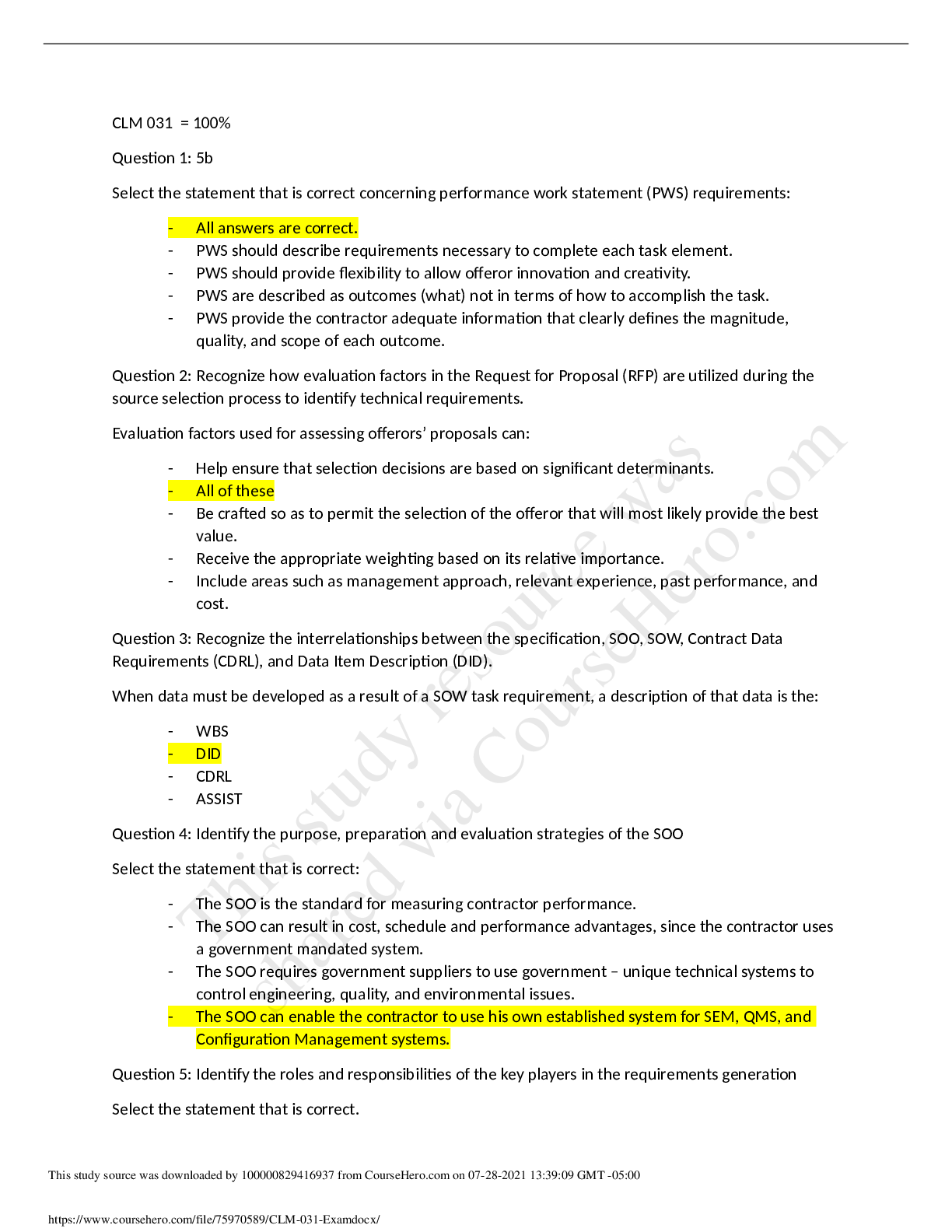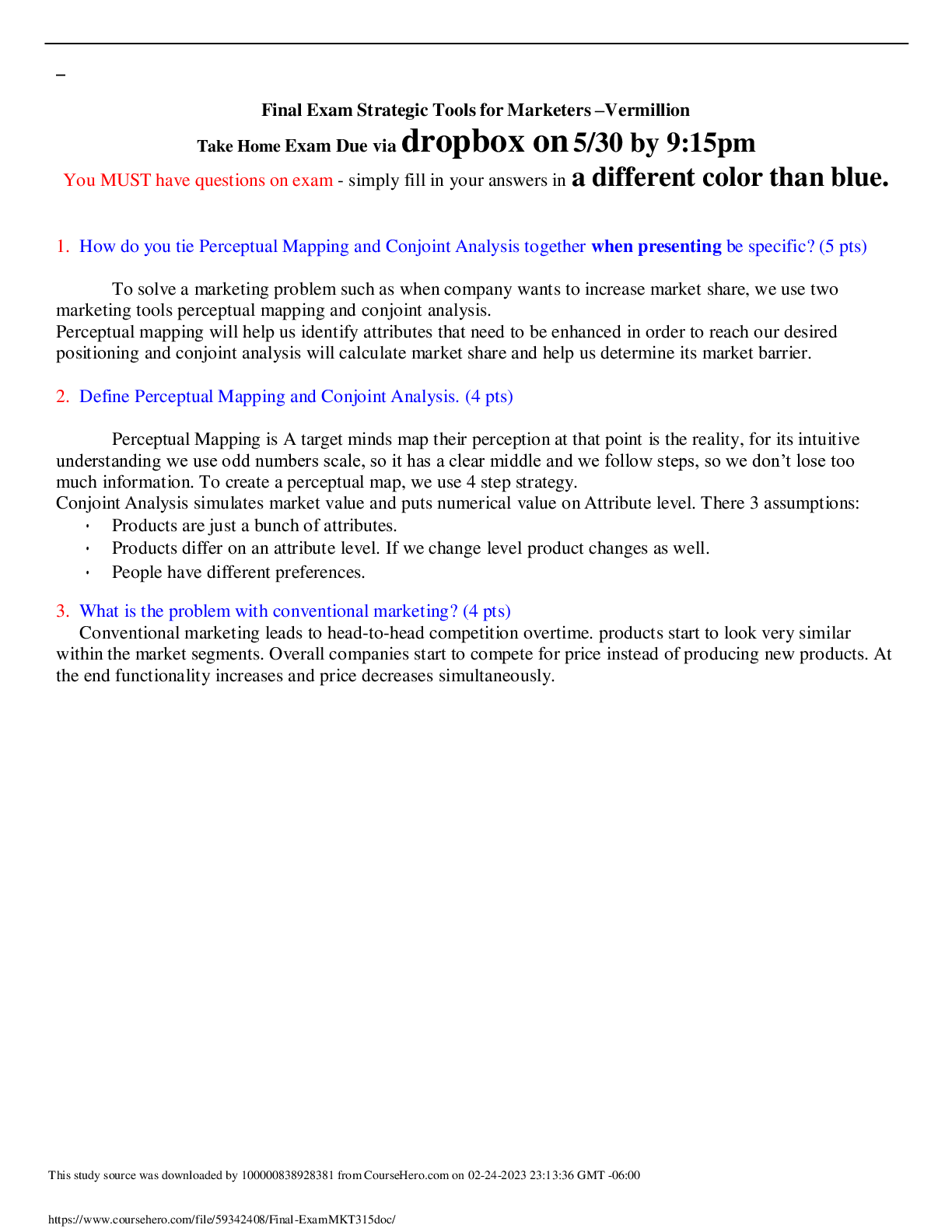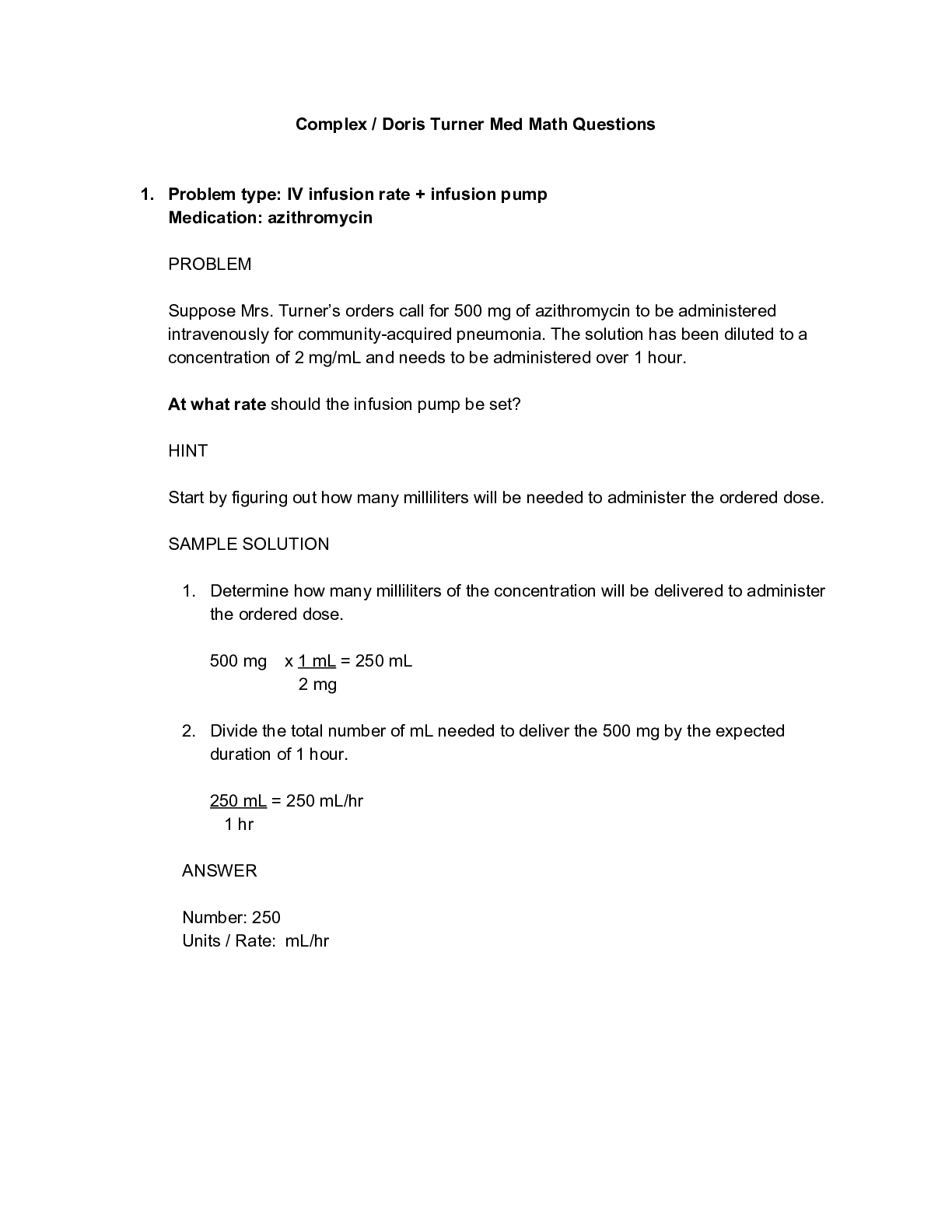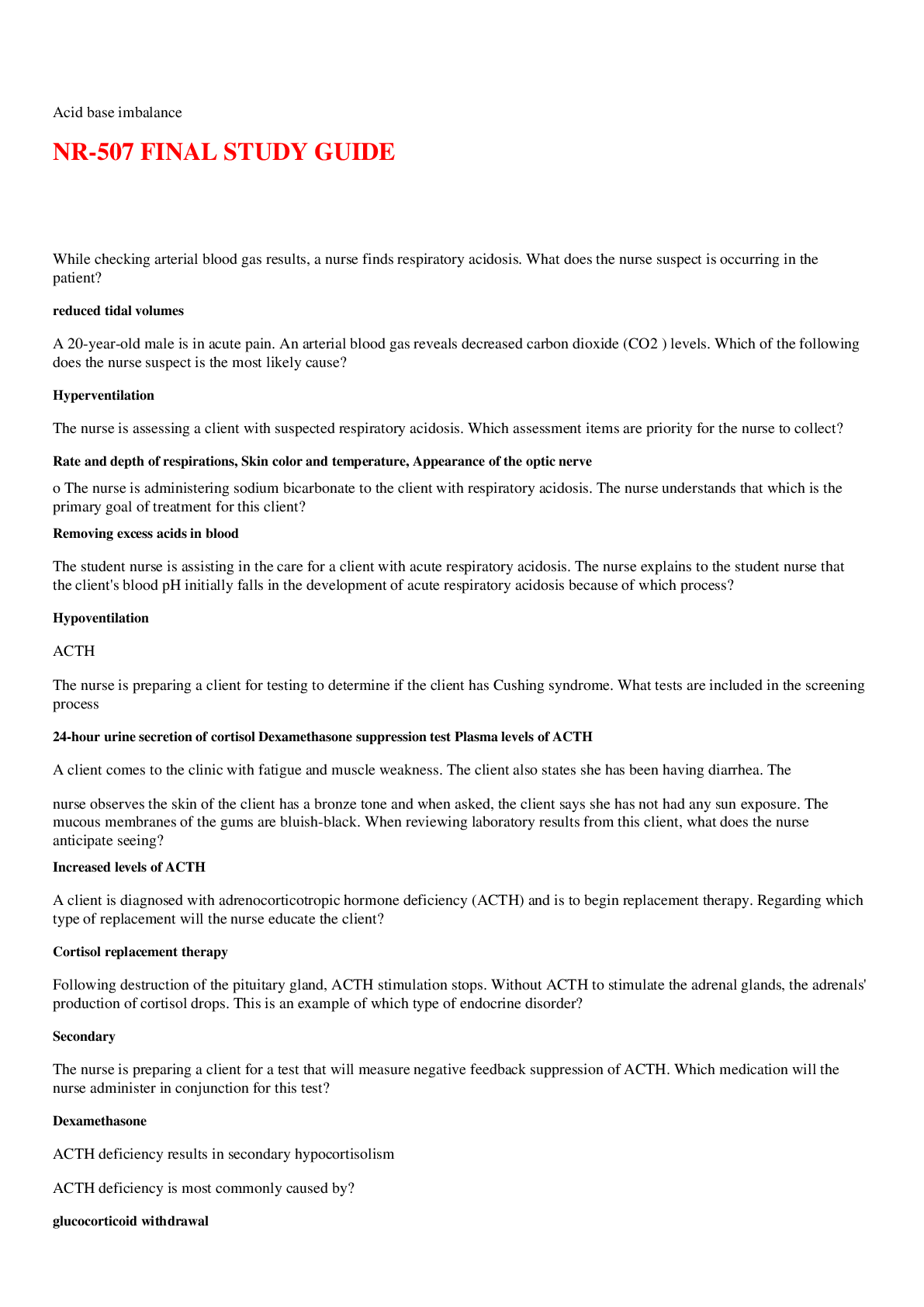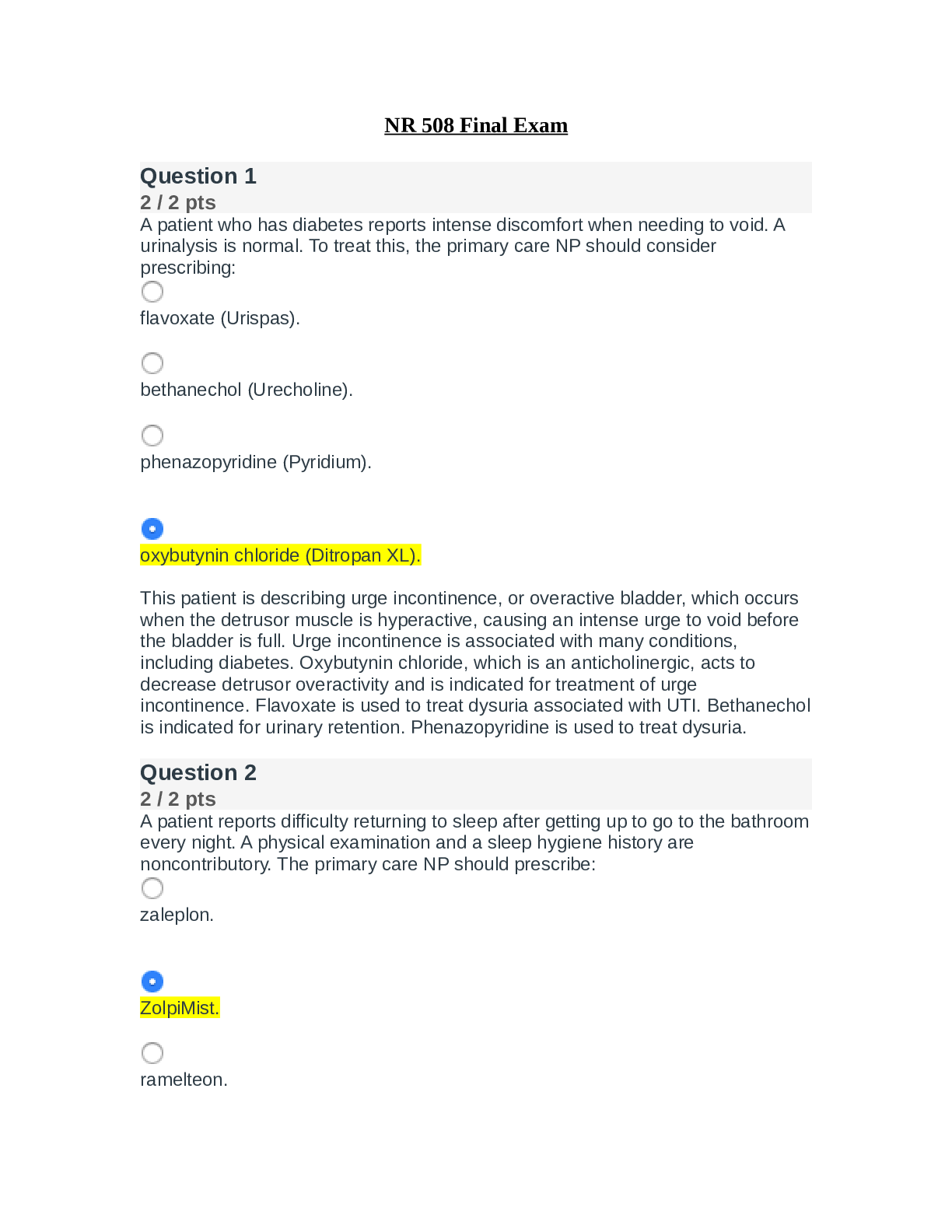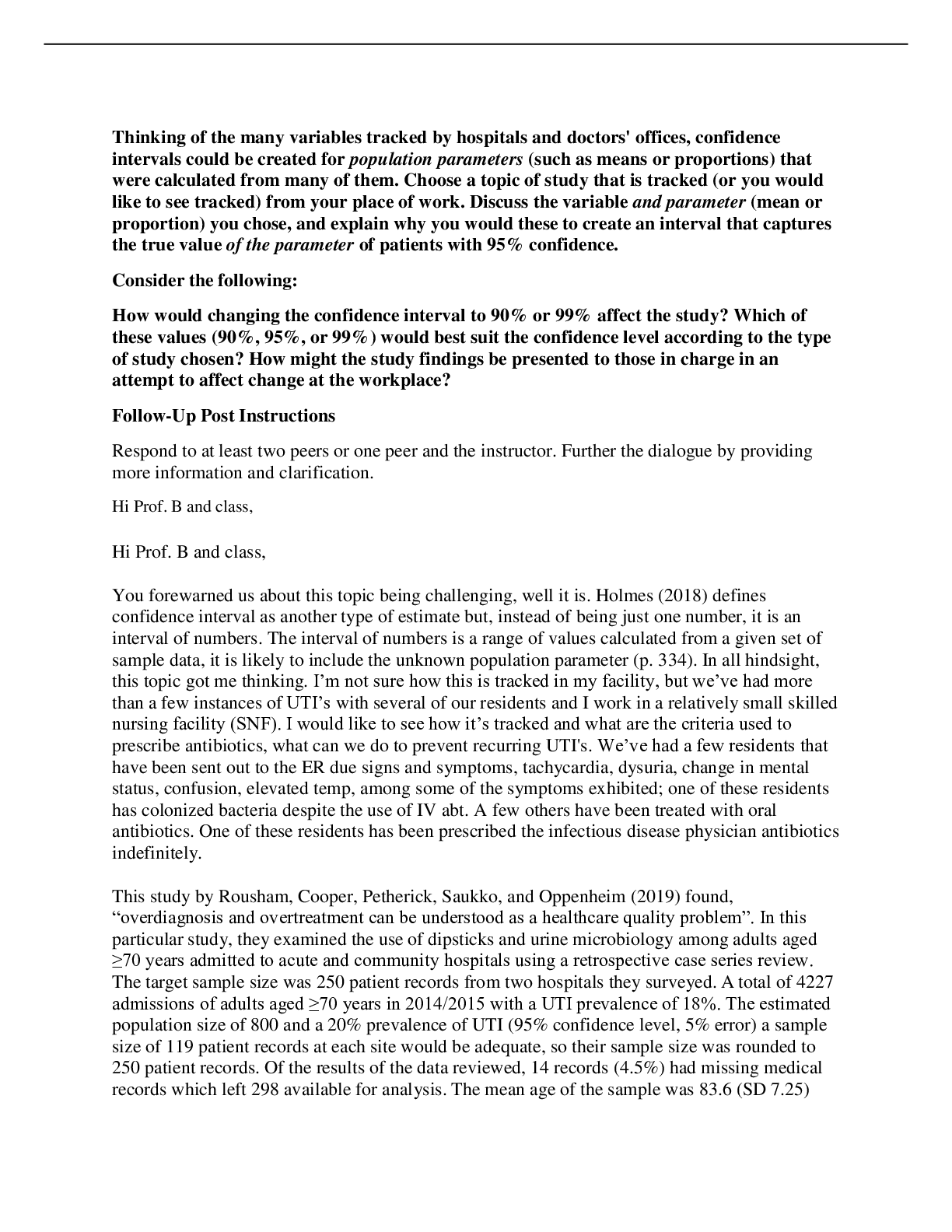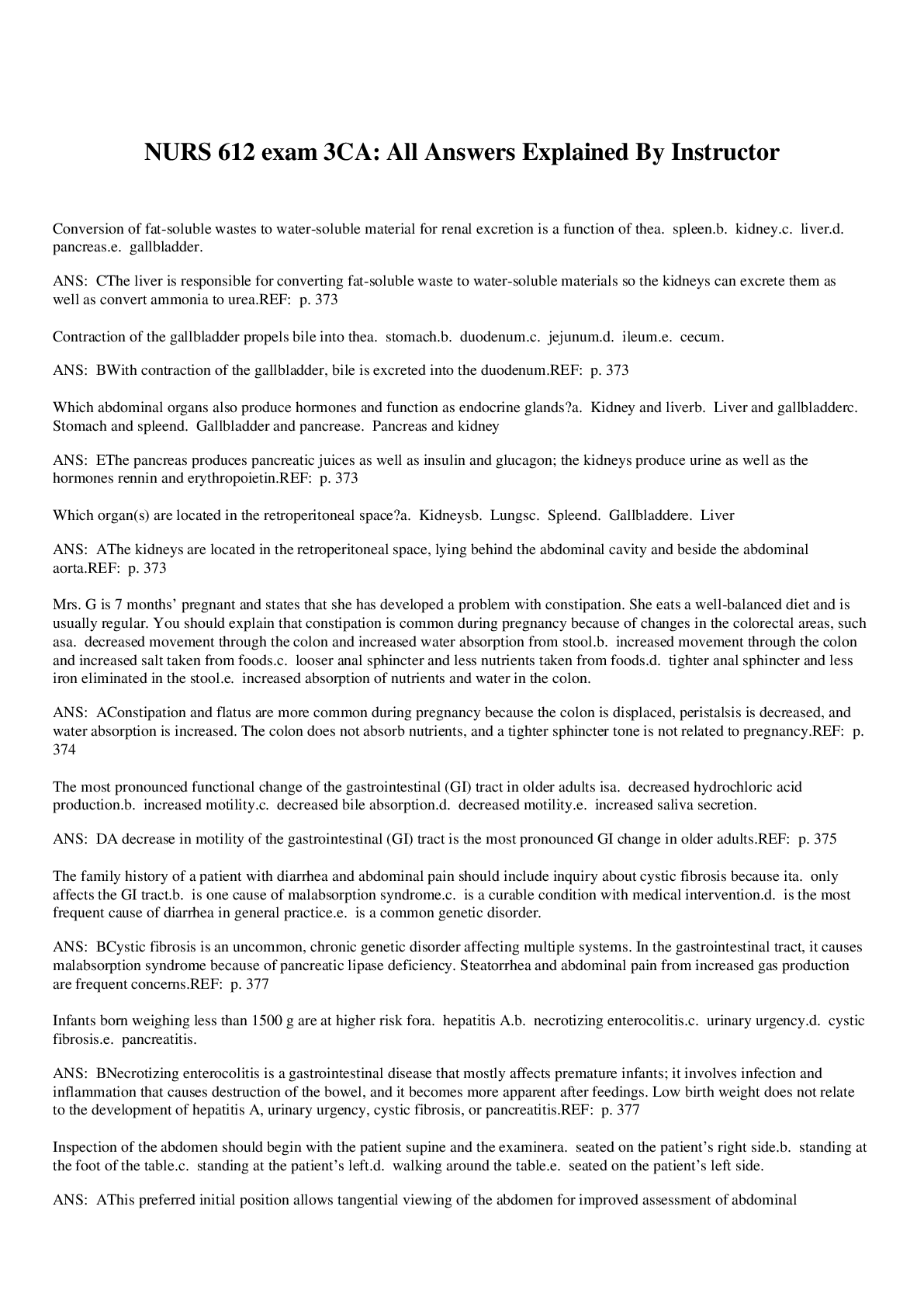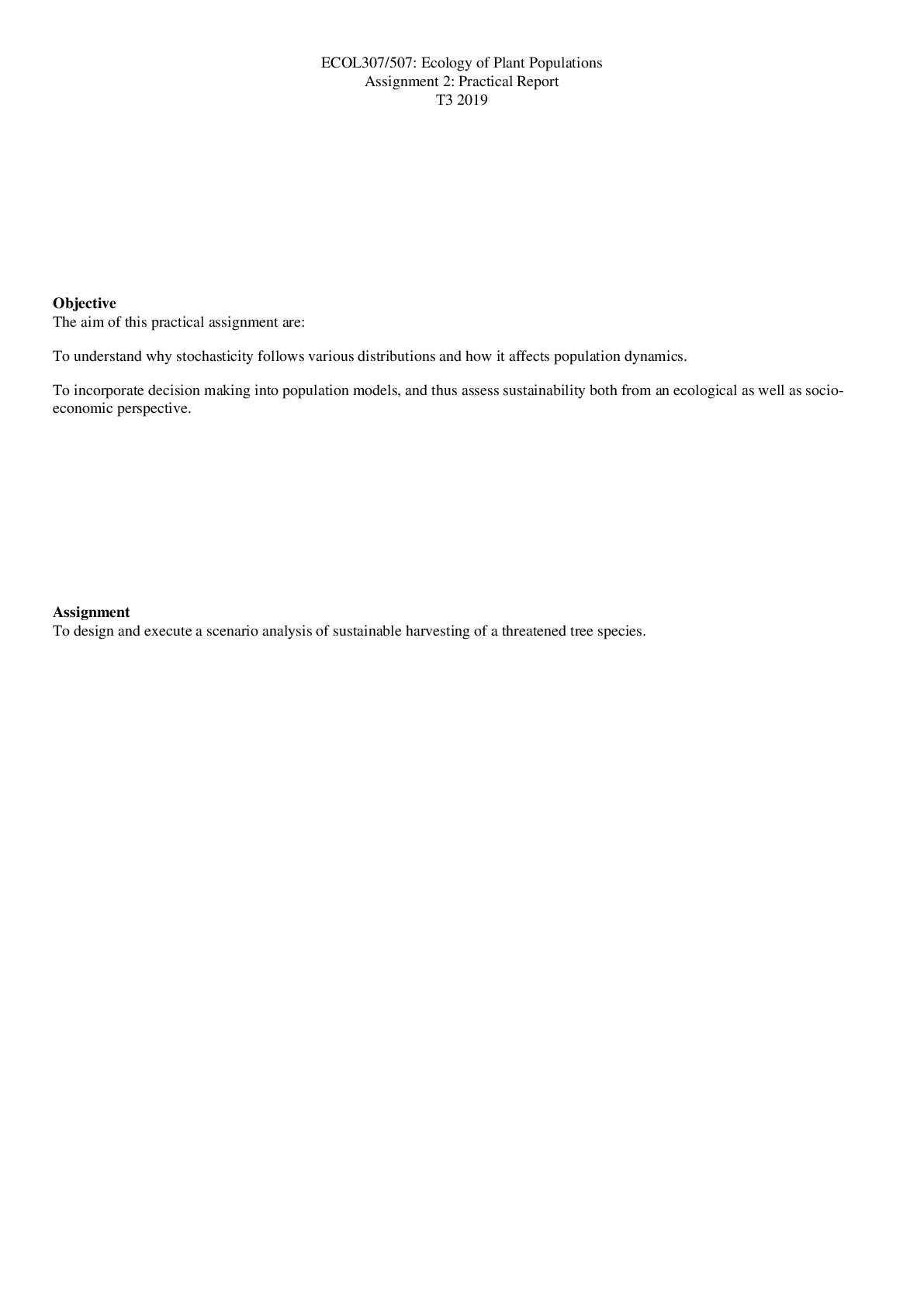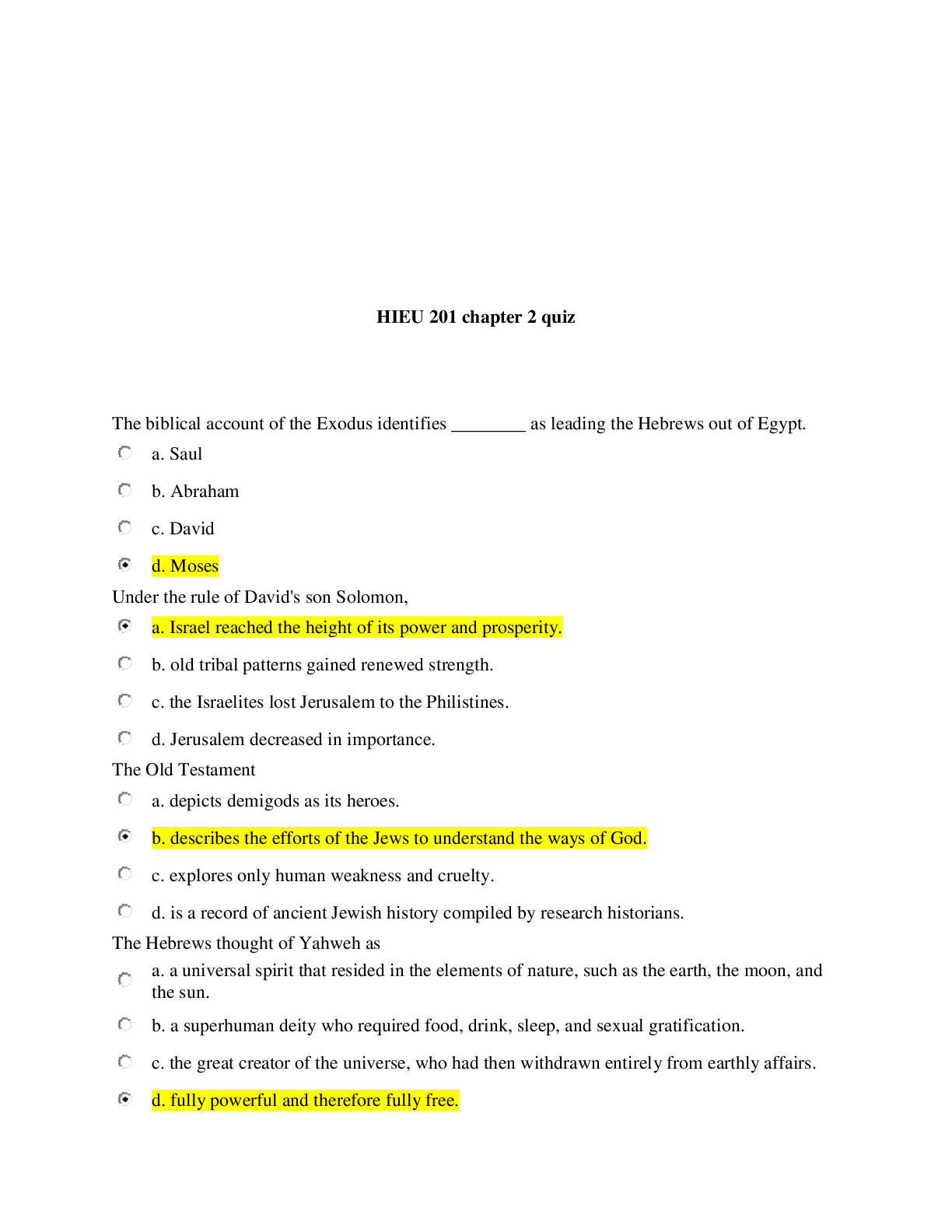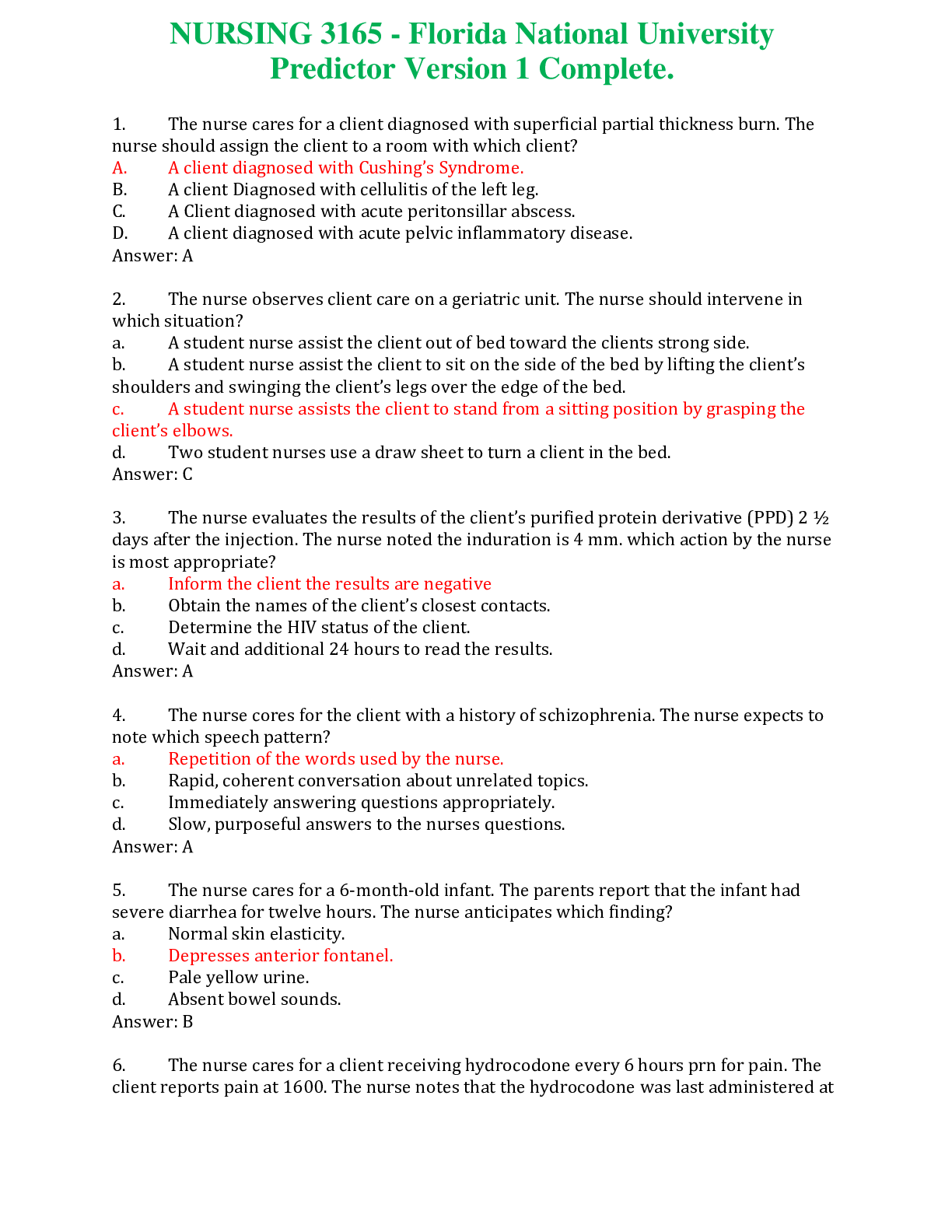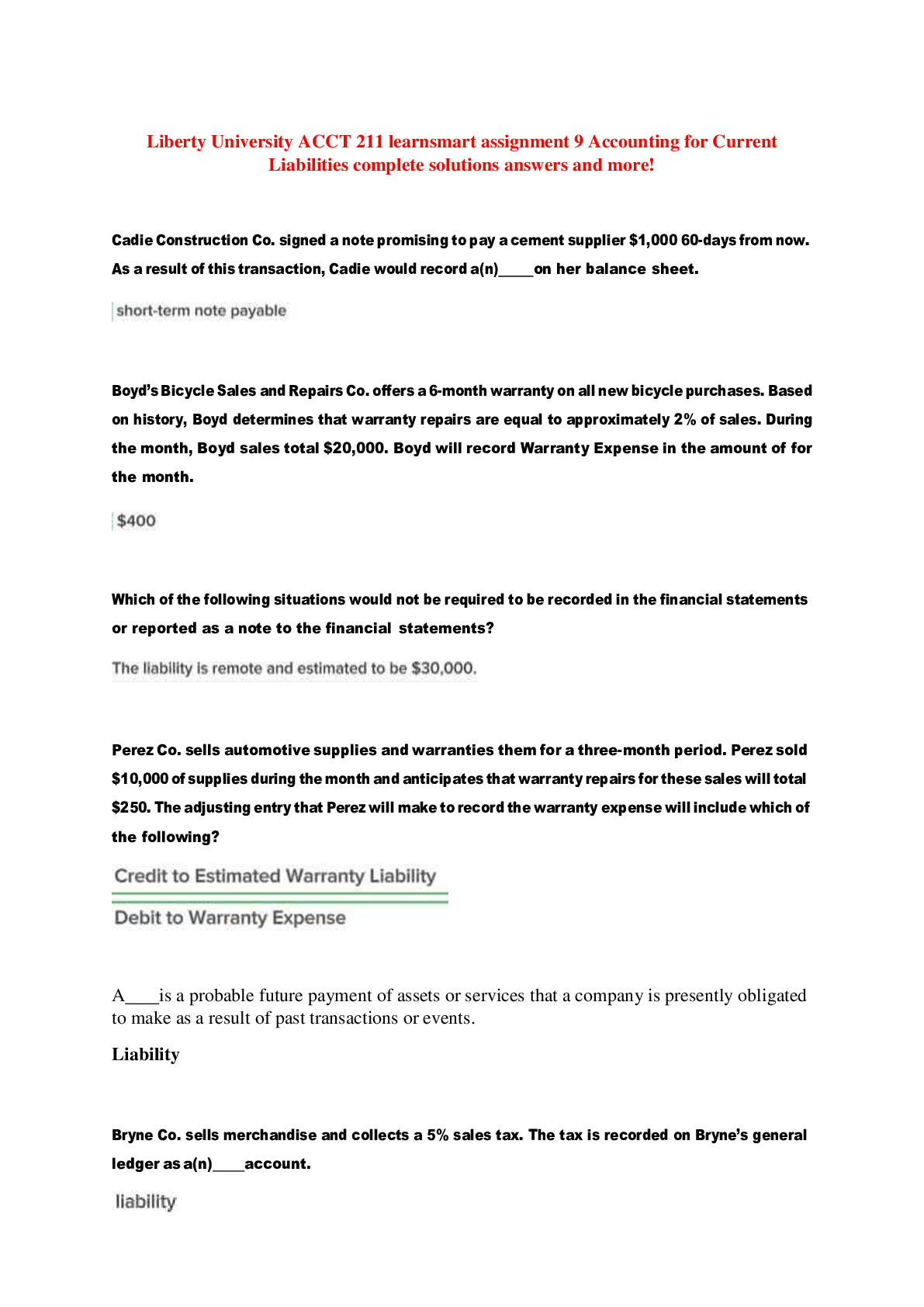Anatomy and Physiology - A&P 1 > QUESTIONS & ANSWERS > BIO201_MH_V3: Autonomic Nervous System (All)
BIO201_MH_V3: Autonomic Nervous System
Document Content and Description Below
BIO201_MH_V3 Topic 15: Autonomic Nervous System Started on Friday, September 10, 2021, 10:11 AM State Finished Completed on Friday, September 10, 2021, 10:36 AM Time taken 24 mins 44 secs... Grade 35.00 out of 35.00 (100%) Question 1 Correct 1.75 points out of 1.75 Flag question Question text The vagus nerve carries parasympathetic impulses to the Select one: a. salivary glands. b. lacrimal glands. c. smooth muscle of the eyes. d. thoracic and abdominal viscera. e. thyroid gland. Question 2 Correct 1.75 points out of 1.75 Flag question Question text Stimulation by the autonomic nervous system results in increased insulin secretion from the pancreas during and after a meal. The following are most likely to be true. Select one: a. increased insulin secretion is due to parasympathetic stimulation b. acetylcholine agonists will stimulate insulin secretion c. increased insulin secretion is due to sympathetic stimulation d. increased insulin secretion is due to adrenergic agonists e. increased insulin secretion is due to parasympathetic stimulation and acetylcholine agonists will stimulate insulin secretion Question 3 Correct 1.75 points out of 1.75 Flag question Question text Which of the following occurs when the parasympathetic system is stimulated? Select one: a. increased blood pressure b. increased motility of the digestive tract c. increased metabolism d. increased heart rate e. decreased motility of the digestive tract Question 4 Correct 1.75 points out of 1.75 Flag question Question text The figure illustrates the autonomic reflexes and the heart. What does "B" represent? Select one: a. sympathetic nerve b. increase in blood pressure detected by carotid baroreceptors c. glossopharyngeal nerve d. decrease in blood pressure detected by carotid baroreceptors e. vagus nerve Question 5 Correct 1.75 points out of 1.75 Flag question Question text Which of the following is NOT an effect of parasympathetic action? Select one: a. increased tear production b. increased motility of the intestines c. increased metabolism d. increased gastric secretion Question 6 Correct 1.75 points out of 1.75 Flag question Question text When norepinephrine binds to adrenergic receptors, Select one: a. Na+ channels open. b. Ca2+ channels open. c. adrenaline is released. d. G proteins mediate the cell's response. e. Na+ channels are closed. Question 7 Correct 1.75 points out of 1.75 Flag question Question text Identify structure "D" on the above diagram. Select one: a. autonomic ganglion b. somatic motor neuron c. effector organ (smooth muscle of GI tract) d. postganglionic neuron e. preganglionic neuron Question 8 Correct 1.75 points out of 1.75 Flag question Question text What part of the brain is in overall control of the ANS? Select one: a. medulla oblongata b. hypothalamus c. thalamus d. cerebrum Question 9 Correct 1.75 points out of 1.75 Flag question Question text Match the phrase to either the sympathetic or parasympathetic division of the autonomic nervous system. Has greater influence during physical activity Select one: a. sympathetic b. parasympathetic Question 10 Correct 1.75 points out of 1.75 Flag question Question text The two divisions of the ANS have antagonistic effects on each of the following EXCEPT Select one: a. the diameter of the blood vessels in skeletal muscles b. the diameter of bronchioles in the lungs c. gastrointestinal peristalsis d. heart rate e. the eye Question 11 Correct 1.75 points out of 1.75 Flag question Question text Which of the following statements is true? Select one: a. The sympathetic division diverges more than the parasympathetic division. b. Increased parasympathetic activity is consistent with increased physical activity. c. One division of the ANS is always stimulatory and the other is always inhibitory. d. Structures receiving both dual autonomic innervation are regulated equally by both divisions. e. There is dual innervation of all organs. Question 12 Correct 1.75 points out of 1.75 Flag question Question text Match the phrase to either the sympathetic or parasympathetic division of the autonomic nervous system. Stimulation of this system often activates many effectors at the same time Select one: a. sympathetic b. parasympathetic Question 13 Correct 1.75 points out of 1.75 Flag question Question text Match the phrase to either the sympathetic or parasympathetic division of the autonomic nervous system. Can produce widespread sweating Select one: a. sympathetic b. parasympathetic Question 14 Correct 1.75 points out of 1.75 Flag question Question text Match the phrase to either the sympathetic or parasympathetic division of the autonomic nervous system. Inhibits heart rate but stimulates contraction of urinary bladder Select one: a. sympathetic b. parasympathetic Question 15 Correct 1.75 points out of 1.75 Flag question Question text Match the phrase to either the sympathetic or parasympathetic division of the autonomic nervous system. Craniosacral division Select one: a. sympathetic b. parasympathetic Question 16 Correct 1.75 points out of 1.75 Flag question Question text Parasympathetic ganglia are called ____ ganglia. Select one: a. pelvic b. chain c. collateral d. terminal e. dorsal Question 17 Correct 1.75 points out of 1.75 Flag question Question text Which of the following is NOT a means of parasympathetic innervation of effectors? Select one: a. spinal nerves b. abdominal nerve plexuses c. pelvic splanchnic nerves and pelvic nerve plexuses d. cranial nerves to the head and neck e. vagus nerve and thoracic nerve plexuses Question 18 Correct 1.75 points out of 1.75 Flag question Question text The figure illustrates the autonomic reflexes and the heart. What does "C" represent? Select one: a. sympathetic nerve b. increase in blood pressure detected by carotid baroreceptors c. glossopharyngeal nerve d. decrease in blood pressure detected by carotid baroreceptors e. vagus nerve Question 19 Correct 1.75 points out of 1.75 Flag question Question text Atropine causes the pupil of the eye to dilate by blocking the effect of muscarinic receptors. This means atropine is a(n) Select one: a. ganglionic blocking agent. b. beta-adrenergic blocking agent. c. alpha-adrenergic blocking agent. d. parasympathetic blocking agent. e. parasympathomimetic agents. Question 20 Correct 1.75 points out of 1.75 Flag question Question text Which effector has no innervation with parasympathetic nerves? Select one: a. eye b. pancreas c. heart d. blood vessels [Show More]
Last updated: 1 year ago
Preview 1 out of 14 pages
Instant download
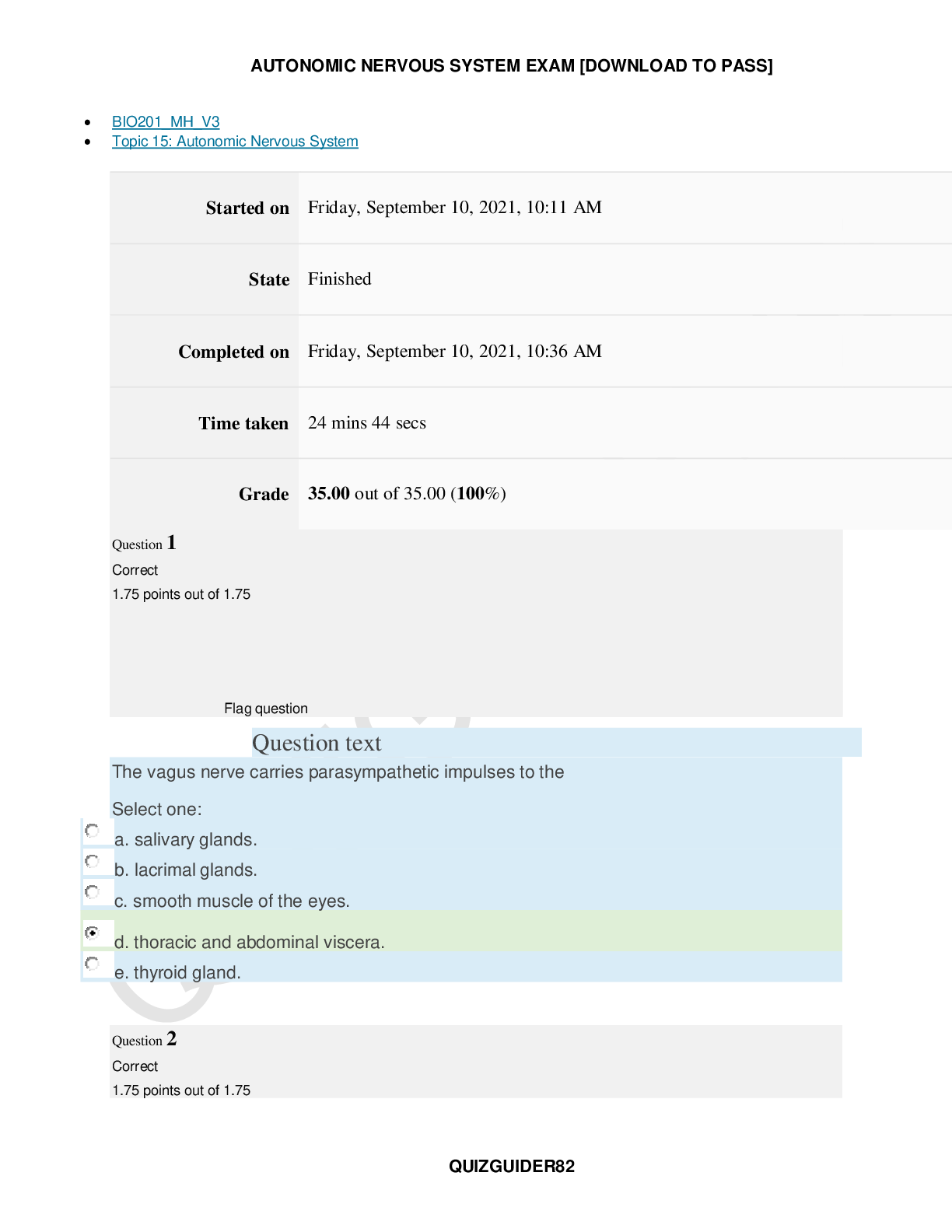
Buy this document to get the full access instantly
Instant Download Access after purchase
Add to cartInstant download
Reviews( 0 )
Document information
Connected school, study & course
About the document
Uploaded On
Dec 03, 2022
Number of pages
14
Written in
Additional information
This document has been written for:
Uploaded
Dec 03, 2022
Downloads
0
Views
88

